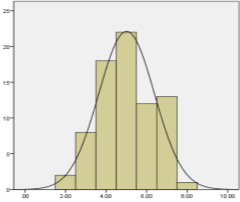The Ancient Chinese [1] course is a basic course for second-grade students who are studying Chinese language and literature in university. After a semester of learning, the final exam in Ancient Chinese of grade 2016 was conducted. A total of 76 people participated in the examination including 13 boys which accounted for 17.1 % of the total students and 63 girls which accounted for 82.9 % of the total.
According to the analysis of the results of the Ancient Chinese final exam paper, the lowest score is 38, the highest score is 90, and the average score is 75.32.
- Basic situation of the final exam of Ancient Chinese course
The Ancient Chinese’s test paper [2] [3] has eight major questions, the first one is a multiple-choice question; the second one is a fill-in-the-blank question, the third one is a translation question; the fourth question is a noun explanation; the fifth question is an explanation of the added words. The sixth question is a short answer question; the seventh question is a classification question; the eighth question is an analysis question. The scores for each question are as follows:
Table 1
Distribution of scores in Ancient Chinese’s papers
|
Question score |
Total students |
Total score |
Lowest score |
Highest score |
Average score |
|
1th question |
76 |
10 |
2 |
8 |
5 |
|
2nd question |
76 |
10 |
1 |
10 |
7 |
|
3rd question |
76 |
20 |
8 |
20 |
17 |
|
Fourth question |
76 |
15 |
0 |
15 |
12 |
|
Fifth question |
76 |
15 |
2 |
14 |
9 |
|
Sixth question |
76 |
10 |
2 |
10 |
9 |
As we can see from Table 1, the average score of the first question is half of the total score, while the average scores of other questions are all more than half of the total score. And except for the first and fifth questions, all other questions have perfect scores. The fourth and eighth question have zero scores.
- The specific situation and analysis of the multiple-choice scores
As the student's first question’s scores lose too much, the following is the analysis of it. The scores of the first questions of 76 students are as follows:
Table2
First question’s score in Ancient Chinese paper
|
Score |
Number |
Percentage(%) |
|
2 |
2 |
2.6 |
|
3 |
8 |
10.5 |
|
4 |
18 |
23.7 |
|
5 |
22 |
28.9 |
|
6 |
12 |
15.8 |
|
7 |
13 |
17.1 |
|
8 |
1 |
1.3 |
|
Total |
76 |
100.0 |

Fig. 1. First question’s score in Ancient Chinese paper (※ horizontal axis represents score, vertical axis represents students’ number)
The first major question has 10 one. The following is an analysis of winning or losing scores of each question.
Table 3
Scores and percentages of multiple-choice
|
Option A |
Option B |
Option C |
Option D |
Total |
||||||||
|
1th question |
Number |
39 |
7 |
10 |
20 |
76 |
||||||
|
Percentage( %) |
51.3 |
9.2 |
13.2 |
26.3 |
100.0 |
|||||||
|
2nd question |
Number |
7 |
43 |
12 |
14 |
76 |
||||||
|
Percentage( %) |
9.2 |
56.6 |
15.8 |
18.4 |
100.0 |
|||||||
|
3rd question |
Number |
2 |
23 |
48 |
3 |
76 |
||||||
|
Percentage( %) |
2.6 |
30.3 |
63.2 |
3.9 |
100.0 |
|||||||
|
Fourth question |
Number |
46 |
10 |
7 |
13 |
76 |
||||||
|
Percentage( %) |
60.5 |
13.2 |
9.2 |
17.1 |
100.0 |
|||||||
|
Fifth question |
Number |
66 |
7 |
2 |
1 |
76 |
||||||
|
Percentage( %) |
86.8 |
9.2 |
2.6 |
1.3 |
100.0 |
|||||||
|
Sixth question |
Number |
0 |
1 |
0 |
75 |
76 |
||||||
|
Percentage( %) |
0 |
1.3 |
0 |
98.7 |
100.0 |
|||||||
|
Seventh question |
Number |
16 |
5 |
39 |
16 |
76 |
||||||
|
Percentage( %) |
21.1 |
6.6 |
51.3 |
21.1 |
100.0 |
|||||||
|
Eighth question |
Number |
11 |
65 |
0 |
0 |
76 |
||||||
|
Percentage( %) |
14.5 |
85.5 |
0 |
0 |
100.0 |
|||||||
|
Tenth question |
Number |
10 |
2 |
40 |
24 |
76 |
||||||
|
Percentage( %) |
13.2 |
2.6 |
52.6 |
31.6 |
100.0 |
|||||||
|
Eleventh question |
Number |
2 |
6 |
56 |
12 |
76 |
||||||
|
Percentage( %) |
2.6 |
7.9 |
73.7 |
15.8 |
100.0 |
|||||||
(1)The analysis of the 5th question’s scores
The answer to the fifth question is A. 66 people choose correctly, accounting for 86.8 % of the total.
The problems and reflection of the teaching process: ① This question has higher accuracy. Most students have a clear idea of the distinction between the Chinese characters “虎” and “人”. In the previous teaching process, “人”, “虎” and some other characters have been copied. If students reviews carefully, they can choose the correct answer. The high accuracy of this question also fully reflects that the student reviews carefully and comprehensively. However, there are still 10 people who choose other options except A, accounting for 13.1 %. It’s very pity that there are some students who don’t make accurate judgments. ② The assessment of the teaching process should be strengthened. There is a small quiz about memorial writing in the process of teaching, so students can make accurate judgments on the words "虎", "人" and "亦" when they answer this question.
(2)The analysis of the 6th question’s scores
The answer to the sixth question is D. There are 75 people who choose the correct one, accounting for 98.7 % of the total. The number of people who choose the right answer is the most and the correct rate of this question is very high. 75 people choose the correctly, and only one chooses B.
The problems and reflection of the teaching process: ① The options of this question have obvious contrast and the option D is more suggestive. While other options still appear in the legend of the origin of Chinese characters, option D is the most reasonable and accurate according to the question and options. ②It is very important to explain in a clear sequence. The legend of the origin of Chinese characters and the way of development of Chinese characters are two aspects. The four options actually include these four contents. Students choose accurately which shows the good grasp of them.
- Conclusion
The knowledge points of multiple choice questions of final examination paper of the Ancient Chinese are distributed comprehensively, involving «nature and characteristics of Chinese characters», " structure of Chinese characters», «evolution of Chinese characters» and «differences of Chinese characters» in characters’ part. Meanwhile, the exam tests the six categories of Chinese characters, phonogram, ideogram, ancient and modern characters, variant Chinese character, interchangeable words, traditional and simplified character, etc. And also text the ability to know, understand, master, etc. The difficulty of this paper is moderate which tests not only basic concepts and definitions, but also tests the ability to analyze specific problems according to the theory. In the next step, we should continue to focus on the following teaching aspects:
(1)In teaching process, curriculum design should be strictly carried out in order to master the knowledge and ability, so that students can firmly grasp the various knowledge points of this course.
(2)Emphasizing on applying theoretical knowledge into practice and strengthening the practical ability.
Sources of the project: General research project of “A Study on The Cultivation Mode of Innovative Talents in Chinese Language and Literature” in Higher Education Academy 2017 in Jilin Province(JGJX2017D160); General research project of “A Study on The Cultivation Mode of innovation ability in Chinese Language and Literature» in the 13th Five-year Plan of education science 2017 in Jilin Province (GH170152); Key research project of «A Study on Self-learning Strategies on Mobile Learning of College Students» Higher Education Society 2018 in Jilin Province (JGJX2018C101);General research project of “A Study on The Construction of Scientific Quality Management System in University» in the 13th Five-Year Plan of Education Science 2016 in Jilin Province (GH16125).
Appendix:(5)Which of the character is not the indicative character?
A. Tiger/person B. Want/And C. Stem/Come D. Mountain/Up
(6)Which is the reasonable explanation of the generation and development of Chinese characters?
A. Developing from the eight trigrams B. Creating Chinese characters by Cang Jie
C. Developing from the tying knots D. Developing from drawing and carving
References:
- 王力.古代汉语(第一册) [M].北京:中华书局,2015.
- 荆贵生.古代汉语习题试卷集解 [M].北京:商务印书馆,2011.
- 李军,张华清.《古代汉语》学习辅导与习题集 [M].济南:齐鲁书社,2006.







